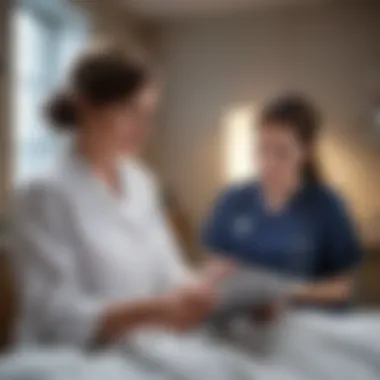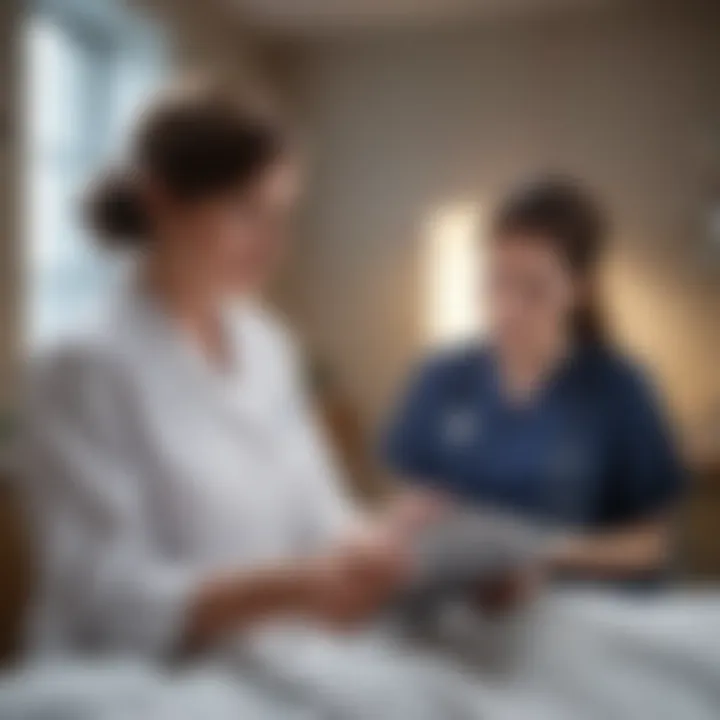Nurses as Key Educators in Patient Care


Intro
The involvement of nurses in patient education is a crucial component of healthcare today. They serve as educators, guiding patients through complex medical information, which is essential for improving health outcomes. This role requires a deep understanding of both medical knowledge and effective communication strategies. The interplay between these elements shapes how well patients can adhere to medical instructions.
Throughout this article, several significant aspects will be examined. It will first introduce key concepts and terminology related to patient education. Then, it will delve into the main findings from recent research on nursing strategies that enhance understanding and compliance. The implications for healthcare systems will also be discussed, shedding light on the pivotal role nurses play in shaping patient experiences and outcomes.
Preface to Patient Education
Patient education is a fundamental aspect of healthcare that empowers patients to take control of their health. This concept encompasses the methods and processes through which healthcare professionals, especially nurses, provide information to patients about their health conditions, treatment options, and necessary care steps. Understanding this vital role has significant implications for patient outcomes.
The importance of patient education in modern healthcare cannot be overstated. It serves as a bridge between medical knowledge and patient understanding. When patients are informed, they are more likely to adhere to treatment plans, manage their conditions, and communicate effectively with healthcare providers. Nurses, in their role as educators, can tailor information to meet diverse patient needs. They must consider factors such as the patient's background, learning preferences, and readiness to learn.
Effective patient education also fosters a collaborative healthcare environment. It allows patients to ask questions, voice concerns, and engage actively in their treatment. This increases the likelihood of better health outcomes and can lead to a decrease in healthcare costs through reduced complications and readmissions.
In summary, patient education is essential for helping individuals understand their health and navigate the complex healthcare system. It enhances patient autonomy and supports health promotion efforts across various settings, making it a critical component in nursing and healthcare overall.
"Educating patients is not just about delivering information; it is about enabling them to make informed decisions regarding their health."
Definition of Patient Education
Patient education refers to the systematic approach through which healthcare providers inform patients about their health issues, treatments, and how to manage their conditions effectively. This education can take many forms, including one-on-one conversations, group sessions, or written materials. The goal of patient education is to ensure that patients have the knowledge and skills needed to make informed decisions about their healthcare.
Importance of Patient Education in Healthcare
The significance of patient education in healthcare is multi-faceted. Here are some key points highlighting its importance:
- Enhances Patient Engagement: Patients who understand their conditions are more likely to participate actively in their treatment.
- Increases Adherence: Educated patients are more inclined to follow treatment regimens and healthcare recommendations.
- Improves Outcomes: Effective patient education can lead to better health outcomes, reducing complications and hospitalizations.
- Supports Self-Management: Providing the right information empowers patients to manage chronic diseases like diabetes or hypertension effectively.
- Reduces Healthcare Costs: Educated patients can avoid unnecessary visits or complications, leading to decreased healthcare expenses.
The Nurse's Role in Patient Education
In modern healthcare, the role of nurses extends beyond clinical tasks. Nurses are central to the process of patient education. They serve as primary sources of information for patients, guiding them in understanding their health conditions, treatments, and self-care strategies. This role is crucial for promoting better health outcomes and ensuring patients feel empowered in their own care.
Nurses possess unique skills that make them effective educators. They have close interactions with patients, which builds trust. This trust is essential for enabling open communication. Patients are likely to share concerns, ask questions, and discuss their experiences. Consequently, this creates a conducive environment for education. Through effective patient education, nurses can reduce anxiety and help patients feel more in control.
Moreover, the strategies that nurses utilize can significantly affect the success of health interventions. By employing various teaching methods tailored to individual patient needs, nurses can enhance patient understanding and adherence. The implications of this role are extensive. Poor patient education can lead to misunderstandings, which may result in medication errors or noncompliance with treatment plans. Thus, patient education by nurses plays a key role in safe healthcare delivery.
Nurses as Educators
Nurses are not just providers of care but also educators who play a vital role in health literacy. They teach patients about their illnesses and treatment options, helping them navigate complex information. They employ various educational strategies, such as one-on-one counseling, group sessions, and hands-on demonstrations. This multifaceted approach ensures that education is accessible and effective.
By incorporating teaching into their daily routine, nurses ensure that patient education is not an afterthought. They assess patients' levels of understanding and adapt their teaching style accordingly. For instance, when explaining medications, nurses clarify dosage instructions and potential side effects. This actively involves patients in their own health management, fostering a sense of accountability and empowerment.
Integration of Education in Nursing Practice
The integration of education into nursing practice is not only beneficial but necessary in contemporary healthcare settings. While clinical skills are essential, education is an equally important component of nursing care. Integrating education into nursing practice involves embedding teaching moments into daily interactions, thus ensuring that education is continuous and context-driven.
This approach encourages a proactive stance on patient health. Nurses can utilize electronic health records to track a patient's educational needs over time. For instance, during follow-up visits, nurses can reinforce previously discussed information and introduce new topics as patients' conditions change.
Also, there is a collaborative aspect to this integration. Nurses often work alongside physicians, pharmacists, and other healthcare professionals. Together, they create comprehensive educational strategies tailored to specific patient needs. This teamwork ensures coherent messaging and decreases the likelihood of conflicting information, further reinforcing patient learning.
Educators in nursing must stay informed about new educational techniques and resources. Continued professional development is essential to maintain best practices in patient education. Regular training sessions or workshops can enhance nursing skills in this area, ultimately promoting better patient outcomes.
Effective Communication Strategies
Effective communication is essential in patient education. It serves as a bridge between healthcare providers and patients, ensuring that information is not only shared but also comprehended. Strategies employed by nurses reflect the understanding that communication is multidimensional, involving not just the words spoken but also tone, body language, and the context within which information is provided.
Verbal Communication Techniques


Nurses often rely on verbal communication techniques to deliver information clearly and effectively. This includes using straightforward language that avoids medical jargon, which can alienate or confuse patients. Employing techniques like the teach-back method can be beneficial. In this method, patients are asked to repeat what they’ve learned in their own words, allowing nurses to assess understanding and clarify any misinformation. Furthermore, pacing is crucial; talking too fast can overwhelm patients, whereas a well-calibrated pace allows for better absorption of information.
- Active Listening: Nurses should practice active listening, demonstrating that they value patients' questions and concerns. This approach promotes an open dialogue, encouraging patients to express themselves freely.
- Open-Ended Questions: Using open-ended questions facilitates deeper conversations. Rather than asking yes or no questions, nurses can encourage patients to elaborate on their feelings and understanding.
Nonverbal Communication and Its Impact
Nonverbal communication often conveys more than spoken words. A nurse’s body language, eye contact, and facial expressions can significantly influence a patient’s perception and comfort level. For instance, maintaining appropriate eye contact can establish trust and convey empathy. Conversely, crossed arms or lack of eye contact may signal disinterest or discomfort, potentially hindering effective communication.
"Nonverbal cues can reinforce or undermine what is being said, making it crucial for nurses to be aware of their own body language as well as that of their patients."
In high-stress situations, such as providing a diagnosis or explaining a complex treatment plan, nonverbal signals can either soothe a patient or escalate anxiety. It is vital for nurses to observe patients’ nonverbal reactions and adjust their communication style accordingly.
Cultural Considerations in Communication
Cultural backgrounds can greatly influence how patients understand and process information. Nurses must consider cultural dynamics when communicating nearly everything, from medical procedures to lifestyle modifications. Understanding cultural beliefs helps in creating an inclusive environment that respects and acknowledges diverse perspectives.
- Language Barriers: Some patients may have limited proficiency in the dominant language. Nurses may need to use translation services or provide written materials in the patient's preferred language for better understanding.
- Cultural Sensitivity: Being aware of different cultural norms surrounding health, authority, and body language can guide nurses in their approach. For example, some cultures may value direct eye contact, while others may consider it disrespectful.
Recognizing these cultural considerations strengthens the nurse-patient relationship and promotes a more effective educational strategy.
Tailoring Education to Patient Needs
In the realm of healthcare, tailoring education to meet individual patient needs is a cornerstone of effective nursing practice. The significance of personalization in patient education cannot be overstated. When education is customized, it resonates more deeply with patients, which enhance their understanding and use of medical information. Customized approaches also promote better engagement, making patients more active participants in their own care.
To address specific needs, nurses must employ strategies that reflect the unique circumstances of each patient. This involves considering various factors such as age, cultural background, and specific health conditions. By focusing on these elements, nurses ensure that the education provided is not only applicable but also applicable and relevant, impacting overall healthcare outcomes.
Assessing Patient Readiness to Learn
Assessing a patient's readiness to learn plays a pivotal role in effective education. Factors such as emotional state, cognitive abilities, and the acute nature of a health crisis can all influence readiness. Nurses are trained to identify these factors through observation and direct communication. For example, a patient recovering from surgery may be more focused on pain management than on understanding discharge instructions.
Conducting an informal assessment, like asking open-ended questions or utilizing brief quizzes, can help nurses gauge understanding before delivering detailed information. This tailored approach helps in guiding the pace and content of education, ensuring that the patient is in the right mindset to absorb essential information.
Understanding Learning Styles
Every individual has a unique learning style, which can significantly affect how they receive and retain information. Nurses should familiarize themselves with the various learning styles, such as visual, auditory, and kinesthetic. Adapting education based on these styles encourages better comprehension.
- Visual learners benefit from diagrams and charts.
- Auditory learners prefer detailed verbal explanations.
- Kinesthetic learners grasp concepts through hands-on demonstrations.
Understanding these preferences helps nurses deliver information in a manner that suits the specific needs of each patient. Thus, a tailored educational approach enhances the likelihood of adherence to treatment recommendations and promotes better health outcomes.
Developing Custom Education Plans
Once a nurse assesses readiness and understands learning styles, the next logical step is developing custom education plans. These plans should be goal-oriented and include specific outcomes based on the patient's health needs. The plans should also be adaptable, allowing for modifications as necessary.
For instance, a diabetic patient may need a plan that includes dietary guidance, medication management, and routine blood sugar monitoring. The education plan could outline actionable steps, resources such as brochures or websites, and follow-up sessions to reinforce information retention. By meticulously crafting these plans, nurses equip patients with the tools they need to manage their health effectively.
"Tailoring education not only benefits patient understanding, but it also builds trust and enhances the nurse-patient relationship."
Using Educational Materials Effectively
In the current healthcare landscape, the effective use of educational materials is paramount for fostering patient understanding. With the complexity of medical information, nurses must leverage suitable tools and resources to maximize the impact of their patient education efforts. This significance lies in both improving patient outcomes and enhancing the overall quality of care.
Print vs. Digital Materials
The choice between print and digital materials shapes the way information is delivered to patients. Print materials, such as brochures and pamphlets, offer tangible resources that patients can refer to at their convenience. They are often preferred in environments where digital access may be limited or where patients may struggle with technology. In contrast, digital materials provide the advantage of interactivity and dynamic content. Patients can access educational videos, interactive quizzes, and up-to-date resources instantly through smartphones or tablets. Thus, recognizing the patient demographic is crucial in deciding the format to employ.
- Benefits of print materials:
- Benefits of digital materials:
- Easy to use for individuals with limited tech skills.
- Physically available for reminders and reference.


- Access to a wider range of content.
- Often updated to reflect new information quickly.
The integration of both formats can offer a more comprehensive approach, catering to different preferences and increasing the effectiveness of education.
Visual Aids in Patient Education
Visual aids play a critical role in patient education. These resources, including charts, diagrams, and infographics, can simplify complex concepts. Patients often retain information better when it is presented visually. For example, a diagram illustrating human anatomy or a flowchart showing treatment steps can make understanding easier. Providing visual context can also complement verbal instructions, ensuring that patients have multiple reference points to reinforce their learning.
- Types of visual aids:
- Diagrams that outline procedures or anatomy.
- Infographics that summarize vital statistics or healthcare tips.
Visual aids also help accommodate various learning styles. They can make education appealing and accessible, especially to those who may not benefit from traditional text-heavy materials.
Patient Safety Information and Instructions
Patient safety information is essential in healthcare education. It informs patients about potential risks and the correct steps they should take to avoid complications. Nurses should ensure that this information is clear and easily understandable. For instance, medication administration instructions, such as when and how to take a specific drug, must be clearly explained, whether through written guidelines or verbal communication.
A few key considerations include:
- Clarity: Use simple terminology and avoid medical jargon to prevent confusion.
- Illustrations: Incorporating visuals can further aid comprehension and adherence to instructions.
Overall, when effectively utilized, educational materials can empower patients, enhance their safety, and contribute significantly to positive healthcare outcomes.
"Empowerment through education is the key to controlling one's health."
Continuing to adapt and refine these materials in line with emerging technologies and patient needs will support nurses in enhancing their educational role.
The Impact of Patient Education on Health Outcomes
Patient education serves as a pivotal component in the healthcare continuum, particularly through the lens of nursing. Its role in influencing health outcomes is multifaceted, affecting adherence to treatment plans, hospital readmission rates, and overall patient satisfaction. Each of these elements has a significant tie to how well patients comprehend the information presented to them and how effectively they can implement that knowledge in their care. By enhancing patient education, nurses contribute to better health management and more favorable healthcare experiences.
Improving Patient Adherence
Patient adherence, often termed compliance, relates to how well patients follow prescribed medical regimens. Clear and effective education from nurses aims to transform patients into active participants in their own healthcare strategies. When nurses provide understandable and relevant information, patients are more likely to follow guidelines for medication, lifestyle changes, and follow-up appointments.
- Importance of Engagement: Engaged patients tend to express higher levels of acceptance for their treatment plans. This is achieved by imparting knowledge in a way that resonates with their personal experiences and beliefs.
- Use of Reinforcement: Strategies such as verbal reinforcement, demonstration of medication techniques, and continuous support help solidify this adherence
Through these educational efforts, the likelihood of complications from non-adherence decreases, which in turn augments overall health outcomes.
Reducing Hospital Readmission Rates
Reduced rates of hospital readmissions signify a healthcare system that is functioning efficiently. One key factor is the education patients receive before discharge from a healthcare facility. Nurses play a crucial role in ensuring patients leave with a comprehensive understanding of their discharge instructions, medication regimens, and signs to monitor that may indicate complications.
- Effective Transition Plans: Educating patients about potential risks and preventive measures reduces ambiguity, which is often a cause for readmission. A well-informed patient is less likely to feel the need for immediate return to the hospital.
- Follow-Up Education: Nurses can also ensure that educational resources are available for post-discharge support, whether through scheduled follow-ups, phone calls, or community resources.
By implementing strong educational strategies, nurses can significantly impact these metrics, contributing to more sustainable healthcare practices.
Enhancing Patient Satisfaction
Patient satisfaction is increasingly recognized as an essential measure of healthcare quality. It is closely linked to how well patients understand their care, and educational efforts by nurses play a profound role here. Satisfied patients are typically those who feel respected, informed, and heard.
- Tailored Information: When education is personalized and relevant, it caters to the specific needs and preferences of each patient, thus improving satisfaction levels.
- Responsive Education: Nurses must not only provide information but also encourage patients to ask questions and express concerns. This two-way communication builds trust and satisfaction.
A satisfied patient is more likely to engage positively with the healthcare system in the future, creating a cycle of continuous improvement.
"Well-informed patients are not just passive receivers of care; they become active partners in their health journeys."


Barriers to Effective Patient Education
Patient education plays a crucial role in enhancing health outcomes. However, various barriers impede the effectiveness of this education. Understanding these hurdles is vital for nurses and healthcare organizations. Addressing these barriers can lead to better patient comprehension, adherence, and ultimately improved health results. This section will explore three significant challenges: time constraints, patient health literacy issues, and technology accessibility challenges.
Time Constraints in Healthcare Settings
In busy healthcare environments, time is a limited resource. Nurses often face pressure to manage multiple patients simultaneously. This scenario can make it difficult to dedicate sufficient time for patient education. While nurses aim to provide comprehensive information, the reality of high patient loads often forces shortcuts.
Effective education requires thorough discussions and the opportunity for patients to ask questions. When time is limited, patients may leave with a lack of understanding. This can lead to confusion about medication regimens or post-hospital instructions. Prioritizing time for education is critical. Institutions can help by implementing strategies to reduce nurse workloads or scheduling specific time slots for patient education.
Patient Health Literacy Issues
Health literacy refers to a person's ability to obtain, process, and understand basic health information. Many patients struggle with reading and comprehending medical instructions. Research shows that individuals with low health literacy are more likely to have poorer health outcomes. This issue is compounded by complex medical terminology that can be intimidating or confusing.
It is essential for nurses to assess a patient's health literacy. This can be done through simple questions about understanding their condition and the recommended treatment. Then, education can be tailored to their level. Simplifying language and using plain terms can significantly enhance understanding.
However, it’s not only about language. Visual aids and examples can also be used to communicate effectively. Nurses must consider each patient's background and adjust their teaching style accordingly.
Technology Accessibility Challenges
As healthcare increasingly embraces technology, disparities in access can become significant barriers. Not all patients have access to devices or reliable internet connections that make telehealth or digital educational resources feasible. Some may not be comfortable using technology, while others face data privacy concerns.
This situation can marginalize vulnerable populations who need education the most. Nurses should assess individual circumstances and provide alternative resources when technology is not an option. Offering printed materials or one-on-one education sessions can help ensure that all patients receive the necessary information, regardless of their technological skills.
Future Directions in Nursing Education
The landscape of nursing education is rapidly evolving. As health care becomes increasingly complex, the role of nurses in patient education must adapt. Future directions in this field highlight the necessity for innovative approaches to delivering education that are both effective and sustainable. This section explores the importance of these directions, emphasizing key elements like technology integration and ongoing professional development for nurses.
Innovations in Patient Education Technology
In recent years, technology has revolutionized the way patient education is delivered. Innovations like telehealth, mobile health applications, and online educational platforms have made it easier for nurses to reach and educate patients. These tools provide real-time access to information and resources, enhancing the learning experience. For example, mobile apps can offer personalized medication reminders or instructional videos tailored to patients’ conditions.
Another significant advancement is the use of Virtual Reality (VR) and Augmented Reality (AR) in patient education. These technologies can simulate scenarios, allowing patients to engage in interactive learning. This method has been found to improve retention rates and understanding of complex medical procedures. Therefore, embracing these technologies not only improves outcomes but also promotes patient engagement in their own health care journey.
Continuing Education for Nurses
Continuing education plays a crucial role in keeping nurses updated with the latest advances in patient care and education techniques. As health care guidelines change, nurses must remain competent in administering evidence-based education that aligns with current practices. Continuing education also equips nurses with the skills needed to utilize new technologies effectively.
Furthermore, many nursing institutions emphasize the importance of lifelong learning. Professional development opportunities, such as workshops, webinars, and conferences, can significantly enhance nurses’ knowledge and skills. Not only do these platforms provide updated information, but they also foster collaboration among nursing professionals.
Engaging in continuous education aligns with the broader goal of improving patient outcomes. By remaining abreast of changes in health policies and advancements in medical technologies, nurses can deliver accurate and relevant information that empowers patients to take control of their health.
Investing in education for nurses is an investment in patient safety and quality care.
Overall, future directions in nursing education will hinge on integrating innovative teaching methods and facilitating ongoing professional development. By focusing on these areas, the nursing profession will be well-equipped to meet the challenges of an ever-changing health care environment, ensuring that patient education remains a critical component of nursing practice.
End
The conclusion of this article is pivotal in synthesizing the insights gathered throughout the discussion. It highlights the multidimensional role of nurses in patient education and emphasizes the critical implications of this role for the healthcare system as a whole. Understanding the significance of patient education can lead to improved health outcomes, as informed patients are more likely to follow medical advice and adhere to treatment plans.
Furthermore, the conclusion reiterates how effective communication strategies, tailored educational approaches, and the identification of barriers can facilitate better patient engagement. Nurses not only serve as educators but also act as advocates for patients, ensuring that they understand their health conditions and the necessary steps to manage them effectively.
In summary, this comprehensive review enhances our understanding of how ongoing education and support from nurses can lead to increased patient satisfaction and lower healthcare costs. Recognizing this connection is essential for future healthcare practices and policies.
Recap of Key Points
- Nurses play a critical role in patient education, acting as both educators and advocates.
- Effective communication is key to successful patient education.
- Tailoring education to individual patient needs enhances understanding and adherence.
- Barriers such as time constraints and health literacy must be addressed to improve outcomes.
- Future innovations in technology and continuing education for nurses will further enhance patient education efforts.
The Ongoing Role of Nurses in Patient Education
Nurses will continue to occupy a vital space in the realm of patient education. Their ongoing involvement is tied to not only the delivery of health information but also the encouragement of patient empowerment. This empowerment allows patients to make informed choices about their health, which ultimately leads to an improved quality of care and life.
The evolving healthcare landscape, especially with advancements in technology, will introduce new challenges and opportunities for nurses. They will need to adapt their educational strategies, integrating new tools such as digital platforms and telehealth resources to connect with patients. This adaptability ensures that patients receive essential information in a format that suits their needs, transcending traditional barriers often faced in healthcare settings.
Moreover, the emphasis on continuous education for nurses highlights the necessity of staying abreast with the latest medical research and educational techniques. This ongoing development equips nurses to offer contemporary and relevant information to patients, further solidifying their roles as trusted educators in the healthcare domain.







